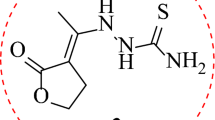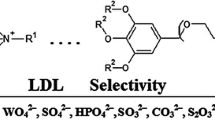Summary
A simple micromethod is described for the determination of hydrazines using the copper ion-selective electrode. The method is based on direct potentiometric titration of the sample in ammoniacal solution of pH 9.5±0.2 with copper(II) ions at room temperature. N-Shaped curves with well-defined inflections at 1∶1 and 1∶2 molar ratios are obtained. This is probably due to the formation of copper monohydrazinate and copper dihydrazinate complexes. Various alkyl and aryl hydrazines and hydrazine salts have been satisfactorily analyzed with an average recovery of 99.4% and a relative standard deviation of ±0.4%. The reaction of hydrazines with Fehling's solution followed by measuring the copper(I) oxide formed using the copper ion-selective electrode also has been investigated.
Zusammenfassung
Eine einfache Mikromethode zur Bestimmung von Hydrazinen mit einer kupferionen-selektiven Elektrode wurde beschrieben. Sie beruht auf der direkten potentiometrischen Titration in ammoniakalischer Lösung mit Cu(II)ionen bei pH 9,5±0,2 bei Zimmertemperatur. N-förmige Kurven mit gut ausgebildeten Spitzen bei Molverhältnissen 1∶1 und 1∶2 wurden erhalten, wahrscheinlich auf Grund der Bildung von Mono- bzw. Dihydrazinatkomplexen des Kupfers. Verschiedene Alkyl- und Arylhydrazine und deren Salze wurden zu 99,4% mit einer Standardabweichung von ±0,4% wiedergefunden. Die Reaktion der Hydrazine mit Fehlingscher Lösung wurde ebenfalls durch Messung des entstandenen Cu(I) mit der erwähnten Elektrode untersucht.
Similar content being viewed by others
Literatur
L. Audrieth and B. Ogg, The Chemistry of Hydrazine. New York: Wiley. 1951. p. 138.
R. Soliman and S. Belal, Pharmazie29, 204 (1974).
H. Britton and M. Konigstein, J. Chem. Soc.1940, 673.
F. Weakley, M. Ashby, and C. Mehltretter, Microchem. J.7, 185 (1963).
S. S. M. Hassan, Z. analyt. Chem.255, 364 (1971).
R. Christova, M. Ivanova, and M. Novkirishka, Analyt. Chim. Acta85, 301 (1976).
S. S. M. Hassan, Analyt. Chim. Acta54, 185 (1971).
S. S. M. Hassan and M. T. M. Zaki, Microchem. J.15, 470 (1970).
N. Cheronis and T. S. Ma, Organic Functional Group Analysis by Micro and Semimicro Methods. New York: Wiley. 1964. p. 289.
A. Terent'ev and K. Zabrodina, Doklady akad. Nauk. S. S. S. R.95, 85 (1954).
T. S. West, Complexometry With EDTA and Related Reagents, 3rd. Ed., Poole: B. D. H. Chemicals Ltd. 1969. p. 181.
Author information
Authors and Affiliations
Rights and permissions
About this article
Cite this article
Hassan, S.S.M., Zaki, M.T.M. Ion-selective electrodes in organic functional group analysis: Microdetermination of hydrazines with the copper electrode. Mikrochim Acta 71, 137–144 (1979). https://doi.org/10.1007/BF01197530
Received:
Revised:
Issue Date:
DOI: https://doi.org/10.1007/BF01197530




